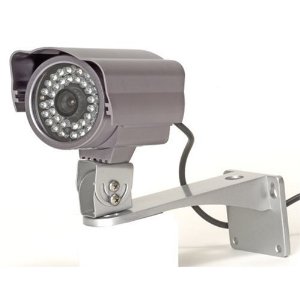Knowing the difference between the two major types of security cameras will help you make the right choice when you finally decide to go with a particular system.
Day/Night Security Cameras:
The human eye sees visible light. When we say it is ‘dark’ outside, what we mean is that there is not enough visible light for use to see. However, it is rarely the case where there is actually no visible light at all. At night there are many light sources that give off some light, it is just usually too dim for us to use with the human eye.
But there is natural light from the moon and stars and artificial light from street lamps, security lights and other sources. This light may be too dim for our eyes to use, but the CCD chips in night vision security cameras can be made to be extremely sensitive to these sources of visible light.
Day/Night security cameras (and many of the high end night vision devices that the military uses) contain this type of sensor that is sensitive to visible light.
There are some advantages to this. Since the camera needs only regular light, you can increase the cameras range and recording ability by simply adding additional normal lighting to areas you want to cover. And because of the camera’s sensitivity, a small amount goes a long way. Also, you will normally record a color picture down to very low light levels until it is necessary for the camera to switch to black and white mode.
The primary disadvantage of Day/Night cameras is that high quality units also usually come at a higher price.
Infrared Security Cameras:

Infrared light can not be seen by the human eye. However sensors in infrared security cameras can use infrared light to show you what is happening in the dark. An infrared security system uses light waves from this portion of the spectrum to give you an image.
Part of the infrared image is captured from the heat given off by an object. So even in total darkness, such as a closed warehouse or garage, an image can still be recorded.
One of the advantages to infrared is that you do not need to have visible light to record an image. There are many cases where you may not want to have security or other visible lighting in an area or in a building. By using an infrared camera, you can still monitor the area easily.
The major disadvantage to using infrared cameras is that they do not give a color picture in low light situations. The image is converted from the infrared wavelengths to a visible picture shown in either black and white or the familiar black and green images we have all seen.
Image Quality or Best Surveillance?
Making your choice for which type of business or home night vision video camera to use comes down mainly to these two items. If you want to use your system to record the best possible image day or night and you don’t mind adding any necessary lighting to areas that may need it for quality coverage, then a Day/Night type camera system is the way for you to go.
If, on the other hand, you don’t want to have visible lights on all night, or you want to monitor areas where adding lighting would be a problem, then you should consider using an infrared security camera wherever necessary.
The choice between the two when comparing outdoor security camera systems is much easier when you know how surveillance and security cameras work.